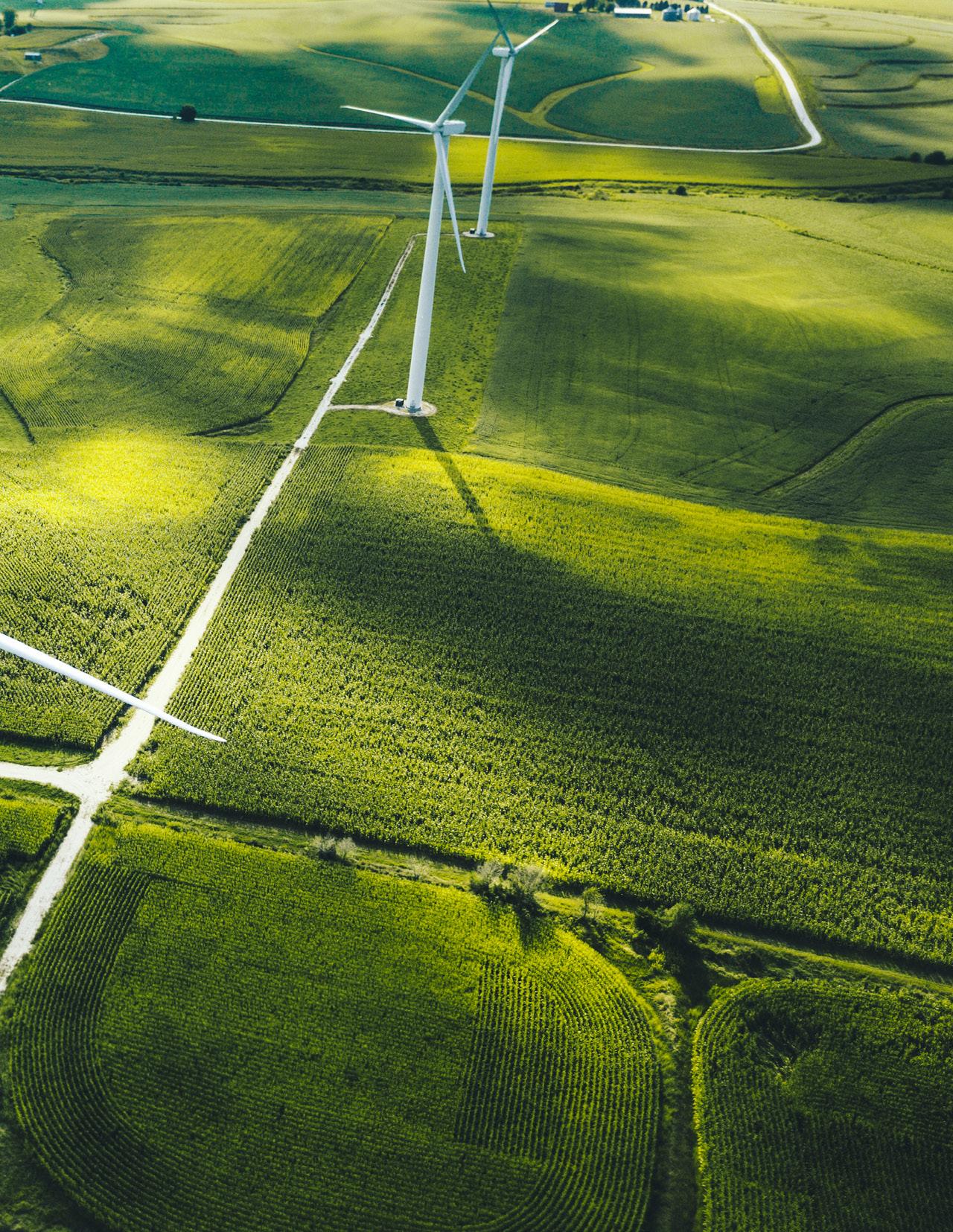
5 minute read
Diversification Opportunities
by Pinion
Wind and solar offer new revenue streams for U.S. agriculture
Food and fiber aren’t the only commodities U.S. farmers and ranchers will bring to market in the next decade. Look for solar and wind ventures to generate additional income for agricultural producers and rural landowners. Both renewable energy sources are gaining ground as state and federal policies pursue aggressive climatechange goals and a greener power grid.
Advertisement
In fact, solar energy has the potential to power 40% of the nation’s electricity by 2035, the U.S. Department of Energy reported in September 2021. The DOE also called solar “our cheapest and fastest-growing source of clean energy.” It’s no surprise, then, that interest in developing solar farms is skyrocketing in states with abundant sunshine, significant agricultural land, mandates for renewable energy and incentives for renewable development.
Likewise, onshore wind energy in the U.S. grew at a record pace in 2020, the DOE’s Office of Energy Efficiency and Renewable Energy said. Wind provides more than 10% of electricity in 16 states, and over 30% in Iowa, Kansas, Oklahoma, South Dakota and North Dakota.

Farmers and ranchers are well-positioned to play a major role in commercial solar and wind expansion largely because they already own a key component: land that can be leased for generating renewable energy. Putting rural properties to non-crop use allows ag producers to diversify their operations and leverage their land base. Maybe that section corner or unused ground – anywhere from 4 to 2,000 acres – can host a solar project. Perhaps those rolling hilltops are the ideal spot for turbine-topped wind towers.
The additional income from wind and solar leases can bolster an industry that often struggles with insufficient and inconsistent commodity prices. It can allow farmers and ranchers to liquidate debt. It yields money that be invested in equipment, technology, land expansion or other needs, including buying out a family member or business partner.
Moreover, wind and solar leases typically work under contracts of 30 years or more, offering long-term income spanning multiple generations. And such projects appeal to the technology-loving next generation. Wind and solar projects offer farmers and ranchers much-needed revenue diversification, just as mineral rights, biofuel production and habitat preservation ventures do. But these fast-growing renewable-energy opportunities also pose challenges for the ag community.
The additional income from wind and solar leases can bolster an industry that often struggles with insufficient and inconsistent commodity prices. It can allow farmers and ranchers to liquidate debt. It yields money that can be invested in equipment, technology, land expansion or other needs, including buying out a family member or business partner.


The business of wind and solar leases
Negotiating wind and solar leases can be complicated. The contract language must define provisions a farm or ranch can live with for two or more generations. It’s important to determine fair market value for the energy produced and for the land that will host wind or power generation. And when the lease ends, the project and restoration funds must leave the land with viable soil that can allow crops to be grown again.
Another challenge to wind and solar involvement is proximity to existing energy infrastructure. Today, wind and solar participation is limited to a distance of 1½ miles from a transmission line or substation. But the Biden Administration’s infrastructure package promotes more renewable energy construction to further expand green opportunities in rural America.
In addition, resistance to change can hold back wind and solar development. That can often start with hesitation to sign a wind or solar power agreement. When big energy companies come into small rural communities, the tendency is to distrust the unfamiliar. That can worsen if a landowner feels pressure to sign a lease with an energy company. Another potential problem is not being informed enough to make a good leasing decision.
With the right advice, however, these power-generating ventures can greatly benefit agricultural businesses and rural landowners, augmenting income for decades to come. Momentum is growing from the Carolinas to Colorado to California. Solar and wind energy generation will play a significant role in the future of U.S. agriculture.
Record growth in wind and solar power
• In 2020, the U.S. installed a record amount of solar—15 gigawatts (GW)—to total 76 GW, representing 3% of the current electricity supply. • A record 16,836 megawatts of U.S. wind capacity was installed in 2020. Wind power installations outpaced those in solar power for the first time in several years and represented $24.6 billion of investment. • Combined, wind and solar will provide 75% of electricity by 2035 and 90% by 2050, transforming the electricity system.
10 tips for negotiating a solar lease
1. Seek competent help. 2. Research the solar company. 3. Address the contract’s duration. 4. Understand access rights. 5. Think ahead about each step of the project, including who will be responsible for what. 6. Be aware of the extent of the solar development on your property. 7. Know your landowner obligations. 8. Make sure the proposed solar lease won’t interfere with existing leases and encumbrances. 9. Look into insurance and indemnification. 10. Include decommissioning and reclamation requirements.
Wind power is growing in America

source: u.s. department of energy
• • • In 2020, wind power surpassed 121,985 MW of total installed capacity. Sixteen states now get 10% of their in-state electricity generation from wind. In 2020, the U.S. added 16,836 MW of new wind power capacity. That’s enough to power nearly 6 • • million American homes. Texas leads the nation in installed wind capacity with 32,686 MW. Iowa produces more of its electricity from wind than any other state, generating 57% of its total • electricity from wind power. In 2020, American manufacturers accounted for more than 71% of domestic small wind sales.








